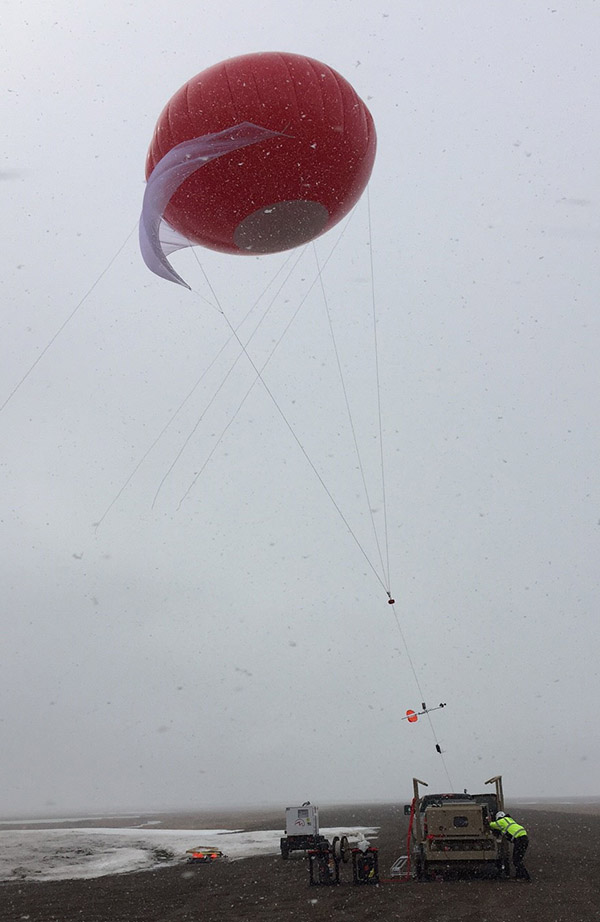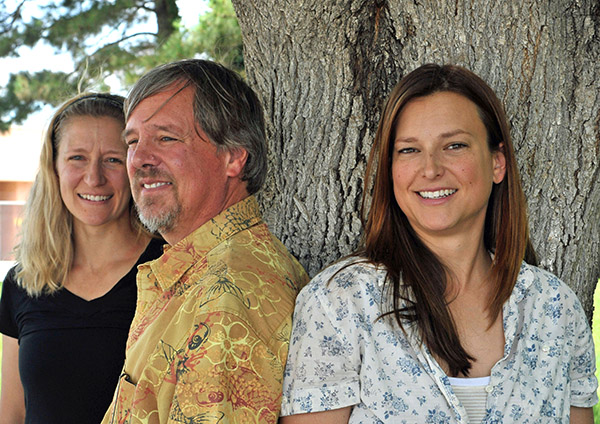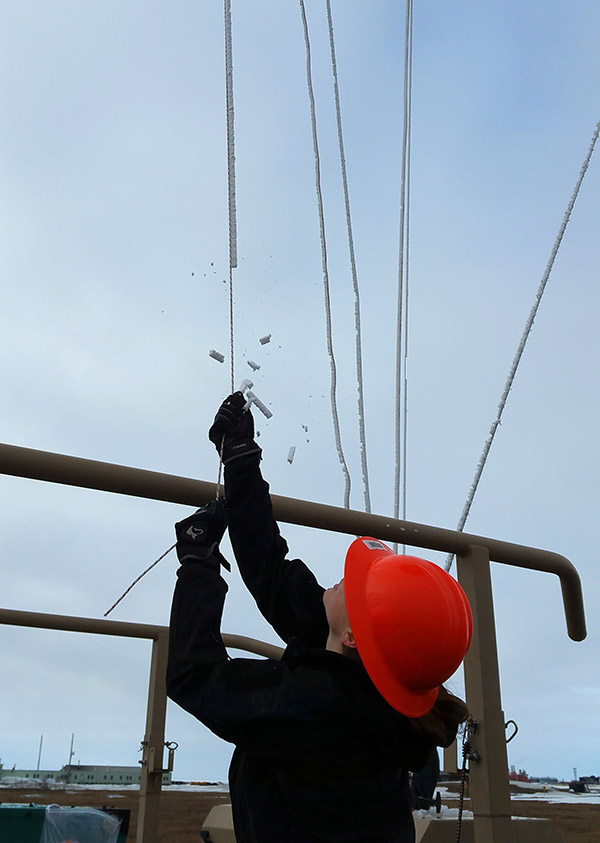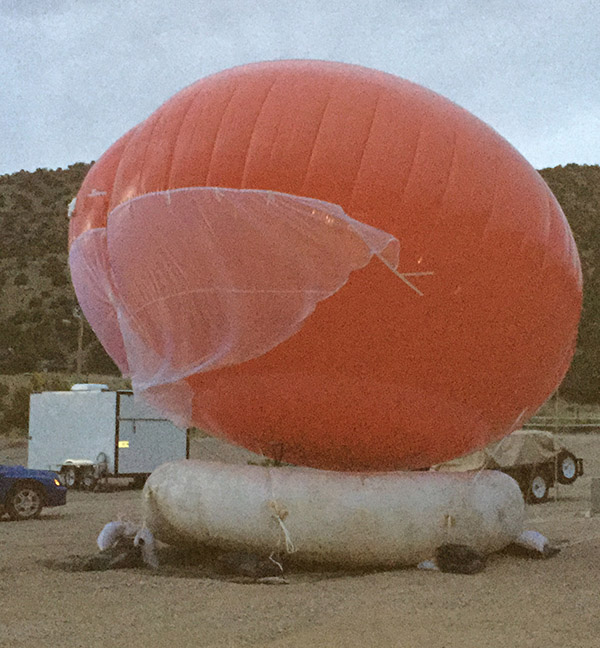Balloons help gather Arctic data on supercooled liquid water

To gather data on arctic climate phenomena, Sandia atmospheric scientist Darielle Dexheimer and colleagues have organized an expedition to fly huge tethered balloons in Alaska this winter, where temperatures descend to 40 below. The balloon in this photo is 13 feet in diameter.
Supercooled liquid water sounds smooth enough to be served at Starbucks, but instead, it hangs out like a bad boy in Earth’s atmosphere, unpredictably freezing on airplane wings and hampering simulations of climate theorists.
To learn more about this unusual state of matter, atmospheric scientist Darielle Dexheimer (6913) and colleagues have organized an expedition to fly huge tethered balloons in darkest Alaska this winter, where temperatures descend to 40 below and it’s dark as a dungeon for all but a few hours of the day.
“We’ll start in November and see how it goes,” she says. The team has been collecting data from tethered balloons in Alaska since 2015, but has not yet operated into the cold season beyond October.
One of the northernmost points in the US
The idea is to wrest more data about the presence and behavior of supercooled liquid water where it is most plentiful and at a location most crucial to climate modelers: at Oliktok Point at the tip of oilfields of Prudhoe Bay, one of the northernmost points of the United States.

Darielle Dexheimer, right, and colleagues Erika Roesler and Joe Hardesty are using balloon-borne instruments to learn more about supercooled liquid water in the Arctic atmosphere. The data has implications for climate models, aviation, and planetary science.
“Supercooled liquid water freezes on impact with aircraft and presents a hazard to aviation,” says Darielle. “The potential for aircraft icing is difficult to model because it’s typically reported in PIREPs [pilot reports] that are subjective and vary in space and time, and from aircraft that are typically attempting to avoid icing. Acquiring in situ icing data in clouds, through use of tethered balloons, eliminates many risks associated with manned research aircraft acquiring that data. These datasets will allow us to better characterize supercooled liquid water in the Arctic for climate modeling and icing research.”
For climate models, there’s not much data in the Arctic regarding how much liquid and ice are in the clouds, when and where clouds form, the altitude at which they hover, or how long they last. Clouds containing a lot of liquid in the Arctic are important to understand, as they can act as blankets to warm the surface. Data about the vertical location and concentration of supercooled liquid water in clouds will help atmospheric scientists better understand how these clouds persist for days even though they contain all three phases of water — liquid, ice, and supercooled.
Where bear? There bear!
There are a few dangers presented by wildlife on the North Slope of Alaska but security in this respect is good, says Al Bendure (4132), the range safety officer for the balloon flights. A large klaxon horn, similar to those used to warn town residents of tornadoes, has been installed to warn researchers of upcoming threats. Al stays in communication with oilfield security people who monitor animal movements through the oil fields that cover the isthmus for which Oliktok Point is the last stop before the Beaufort Sea. There is always a person “qualified to carry a 12-gauge shotgun who provides a ‘bear watch’ during the balloon operations,” he says. “It shoots big enough rounds to kill a bear if it attacks a person.” But, he says, that last-ditch option has never been used — in previous visits, researchers have retreated to the safety of the arctic shelters on site when a bear was spotted and remained inside until the bear left.
But the balloon itself is a challenge. “These 13-foot-tall balloons can easily lift a person, so we need to stay focused,” says Darielle. Ice is expected to form on the balloon and its tether; up to 50 pounds of ice has accumulated on the balloon after flying in clouds. The balloon also can be difficult to control in high winds, and is not launched or retrieved in wind speeds above 25 mph.

A cascade of ice breaks loose from tether lines as Darielle Dexheimer gathers in an instrumented balloon at the ARM research station at Oliktok Point, Alaska. The balloon is about 25 feet above Darielle’s head and the lines are completely iced over. (Photo courtesy of Darielle Dexheimer)
Near-continuous temperature profile
Still, “with data from our instrument-laden balloons and its tether, we can sample in situ for long periods of time — maybe the entire life cycle of a cloud layer, and hopefully use that data to parameterize climate models,” Dari says. “The models currently represent the arctic surface as colder and more stable than it should be in the winter, which results in fewer and shorter duration low clouds than are really happening. Because our sensor data resolution takes place every meter along the tether and we take temperature readings every 30 seconds, we can measure an almost continuous temperature profile along the entire length of the tether during flight. We’ll have a large dataset that isn’t being collected elsewhere that will improve our understanding of cloud processes and hopefully improve the accuracy of climate model output.”
A large winch allows spooling at a steady pace, letting the helium-filled balloon rise slowly through the bottom, middle, and top of the cloud, before slowly taking it back down.
Informing climate models
Says climate modeler Erika Roesler (6913), who supports the effort, “High enough concentrations of liquid water in clouds can warm the surface of the Arctic through emission of thermal radiation. As the Arctic continues to warm, models will most likely predict that 30 years from now there will be less ice and more liquid in clouds when compared to today’s Arctic atmosphere. Data that Darielle is taking will give us a reference point of today for the future and help inform regional climate model predictions.”
Says Joe Hardesty (6913), science liaison, “One of the biggest gaps in understanding cloud formation and stability is how the various processes result in persistent seasonal clouds in the Arctic. Supercooled liquid water that switches state to ice, ice nucleation, temperature inversions where clouds become warmer at the top and colder at bottom, and turbulent air flow are all important drivers of cloud formation and behavior. That’s why models need to be based on sound science, and why we work with DOE’s ARM [Atmospheric Radiation Measurement] program and our partners at NOAA, the University of Alaska, and NASA to generate useful data to improve models for the Arctic.”
The ARM Climate Research Facility is a national scientific user facility funded through DOE’s Office of Science. The ARM Facility is operated by nine DOE national laboratories, including Sandia. Sandia manages the ARM North Slope of Alaska megasite, which includes Oliktok Point.

Scientific balloons 13 feet in diameter carry instrument packages high up into the arctic sky to gather data on arctic climate phenomena.